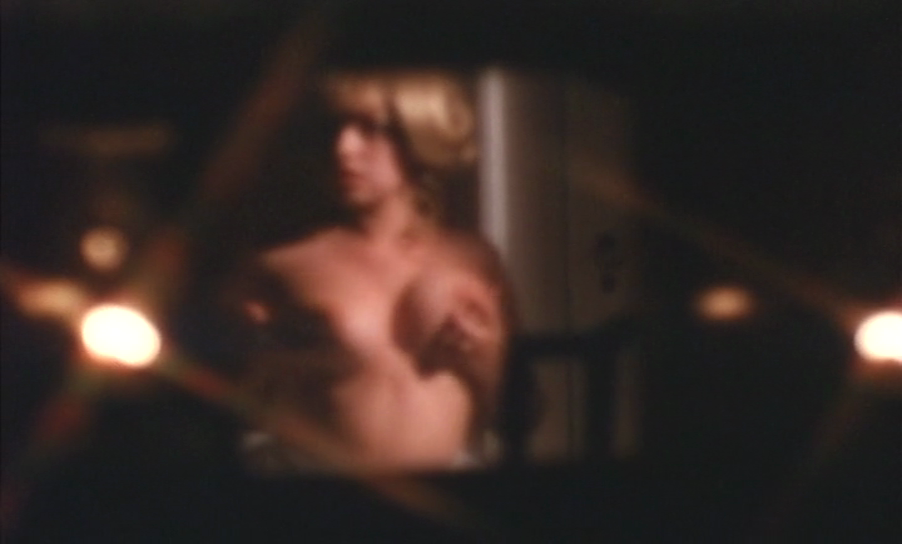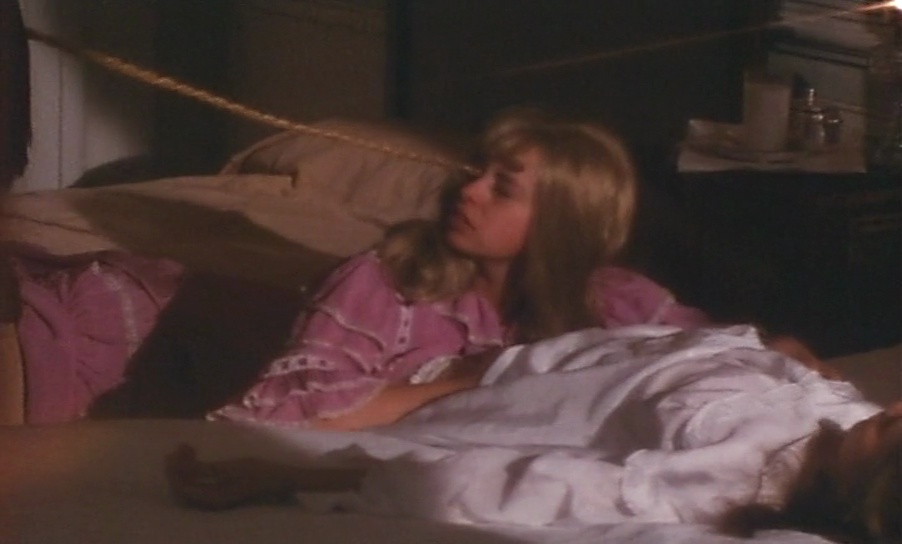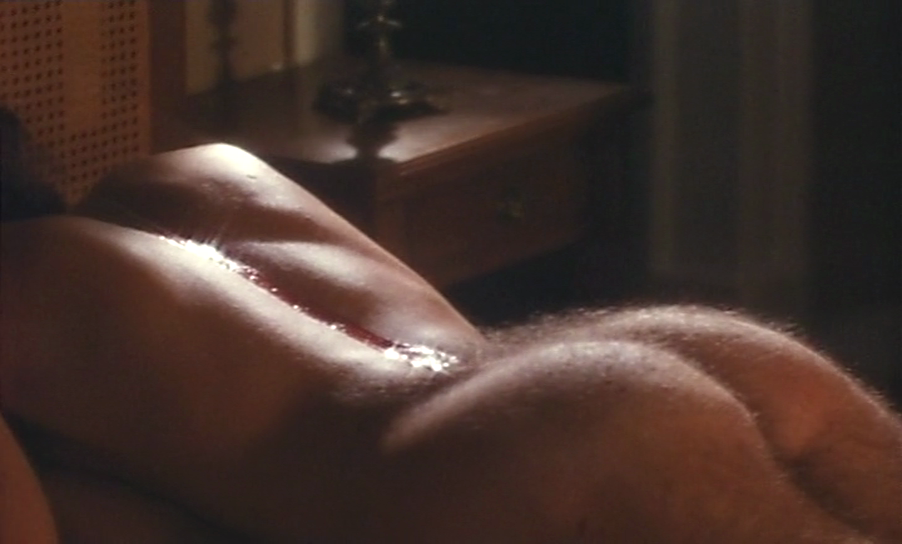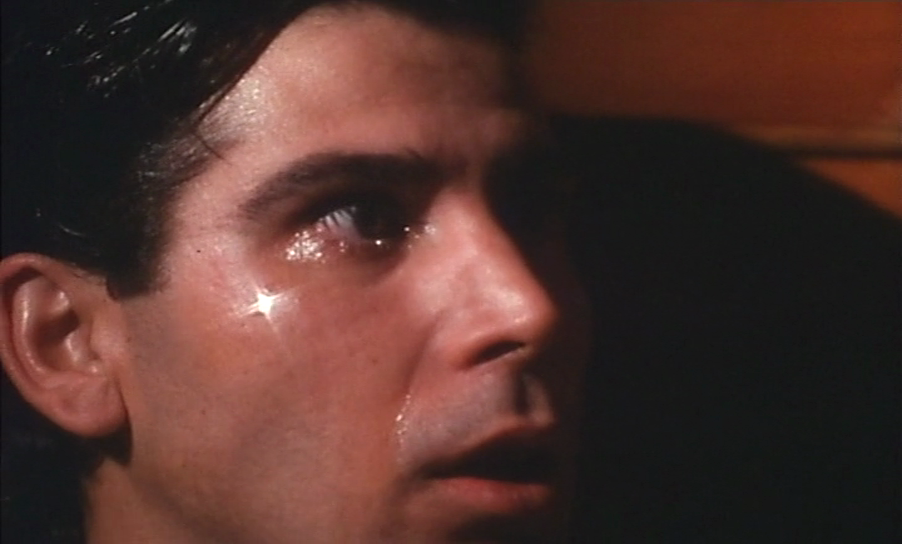

All of us Jess Franco fans know that he was a musician before being a filmmaker, yet we don't know much about his musical tastes. Jazz apart, what musical genre or what composers does he prefer?
The choice of using Franz Liszt's scores in some of his films could give us our first answer. Many Franco fans will remember the trumpet solo in the night-club where Miss Death performs her shows (MISS MUERTE, 1965): it's a transcription from Franz Liszt's Dream of Love No.3 in A Flat Major (as a matter of fact a nocturne), one of those piano "Love Melodies", once very popular, that all good-family ladies and girls liked to play in their houses. Franco has used this sentimental melody numerous times, in the most disparate transcriptions. It will be just the Dream of Love No.3, strummed by Lina Romay on a small piano, which will magically open a strong-box full of gold bars in the last scene of LA NOCHE DE LOS SEXOS ABIERTOS (1981).
However, no classical score has such a great importance in a Franco film as Liszt's Second Concerto for Piano and Orchestra (1839-1861), since its original score forms a large part of SINFONIA EROTICA's musical soundtrack. [See note below.] It suffices to know that Franco used the whole Concerto, except for the 67 bars of “Sempre Allegro”, “Marziale, un poco meno Allegro” and “Un poco animato” (one minute and a half total). The key-importance of this choice is pointed out already in the title: SINFONIA EROTICA is really a film built around a symphonic music score, where the pace of the acting and dialogue adjusts itself to the time of music. It looks as if Franco wrote and shot the film while keeping the different episodes of the Concerto in his mind.
Before talking about the film, it's worth trying to explain what it is in Liszt's music that attracted Franco so much. Probably he was interested in the strong dialectics between popular and experimental typical of Liszt's music; an unusual coupling in the world of classical music, but, at the same time, one of the key-aspects (many times underlined by the director himself) in Franco's cinema.
One of the many Franco's adaptations from the work of Marquis De Sade (Justine's de Bressac episode), SINFONIA EROTICA postpones the action to more than a century later, plunging it in that late-romantic, languid and decadent atmosphere so perfectly embodied by Liszt’s music. The director's aesthetic choices follow from this chronological shifting, beginning with the decadent setting in an old villa, as vast as it is bare, surrounded by an autumnal nature filmed by Franco and cinematographer Juan Soler using French Impressionism as their model. But as Franco has no intention to pay tribute to a costume-film's oleography (he already did this in the late 60s), so, too, he doesn't limit himself to use Liszt's music as an historical element but establishes a deep connection between musical and visual forms. Even more than Wagner, Liszt was the composer who, in 19th century, dissolved the certainties of the classical form. The paratactic structure of his harmonic language and the cyclical (instead of dialectical) form of his compositions are the basis on which he develops those melodies which seem to be wandering about aimlessly (so well represented by the Second Concerto) finding a perfect visual answer in Franco's slow and unforeseeable camera movements and in that extreme dissolution of the space co-ordinates, which is the most fascinating aspect of SINFONIA EROTICA. In all the key-scenes Franco refuses to rationalize the organization of space by means of field depth, but restricts the focus to a portion of an image or even concentrates only on close-ups and details, without the unceasing camera work (almost a subliminal melodic journey) clearly showing us the real structure of the rooms and especially the bedrooms in which most of the action takes place. The rest is darkness, shadows and out-of-focus: forms and techniques already used by Franco, examples of which are easily found in his later movies, but which in SINFONIA EROTICA are realized in a particularly extreme and radical way. What drives the director in this direction is without doubt the need to create a kind of spongy image, fit to become imbued with music; whereas what makes the experiment successful is probably the presence of a new cinematographer, that Juan Soler who, from SINFONIA EROTICA onwards, will work on Franco's side in almost fifty films (also playing in many of them) and who was perhaps his ideal collaborator behind the camera.
Like all the amour-fou stories, SINFONIA EROTICA is also a story of a mental illness. At the beginning of the film we see the Countess Martine de Bressac (Lina Romay) travelling on a carriage through the country. Martine is coming back home after a stay in a mental hospital. At her side in the carriage there's a man with a top-hat who never looks at her – as she never looks at him – but says to her an enigmatic phrase: "I hope everything proceeds in the way you and I wish." This man is Martine's shady psychoanalyst, Dr. Louys (Albino Graziani). Once the door of the villa, which she will never leave till the last scene, is shut behind her, Martine suddenly finds herself immersed in memories which take the form of voices: the love-talk between her and her husband Armand (Armando Sallent) in the first days of their marriage and, immediately after, when Armand insults and repels her.
Martine won't meet her husband until many scenes later, but, in the meantime, she will have learned from Wanda (Aida Gouveia), her loyal lady companion, that during her absence Armand has entered into a homosexual relationship with Flor, a curly-headed youth (Mel Rodrigo).
These few narrative elements make clear that the previously described singular space conception is functional to the creation of a sort of home for the psyche, a "psyche-home", where reality mingles with memory and fancy. The small and big narrative inconsistencies with which the film is studded are nothing else but the reflection of a mental condition – the protagonist's – that periodically takes over and upsets the logical flow of events. Other directors would have striven to go along a double line – the external logic of the facts and the internal logic of the psyche – in such a way as to avoid clashing against the audience's rational categories. Franco, as ever, prefers solutions of shocking “realism” – as he likes to call them – without taking the trouble to save appearances.
By the way, the representation of this psyche-home answers to a cogent logic. In fact, while on the one hand, the bedrooms, that is, the seat of inner experiences and unconscious desires, look like places devoid of spatial coordinates, since their shape is not clear to the viewer; and also the dining-room looks like a fully-lit round table with a white cloth – filmed by incessantly turning the camera around – but surrounded by a mysterious half-darkness; on the other hand, staircases and corridors – that is, the mind's connective functions, which have nothing to do with the thought contents – are clearly shown, and characters go up and down or through them repeatedly – now with a ritual slow pace, now running – in some of the most exciting scenes.
Where psychoanalysis is, there is dream; and, in fact, the very sexual experiences of the protagonist tend to cross the frontier between reality and dream, which, on the other side, appears as vague as in A VIRGIN AMONG THE LIVING DEAD (1971). When, one morning, Martine apologizes to her maid Norma (Susan Hemingway) for having sexually abused her the past night, the girl answers at first that she doesn't understand what her mistress is talking about – therefore giving value to the idea that it was only a dream – but then concludes: “Yo estoi al so servicio, signora Martine: sos deseos son ordenes para mi / I am at your service, Mrs. Martine: your desires are orders for me”, leaving us doubtful.
“I hope everything proceeds in the way you and I wish." According to Dr. Louys' instructions, Martine has come back home with the aim of freeing herself from the source of her depression, but, for the moment, no humiliation is enough to make her change her feeling towards Armand, whom she viscerally loves and obsessively desires. As in every respectable psychoanalytic therapy, sex is the key to everything, and after more than twenty minutes of absolute romanticism, at last Martine acknowledges to herself the true, bodily nature of her desire and resolves to open the door of her husband's room in the attempt – totally unsuccessful for now – to get fucked. From now onwards her actions will be more and more driven by sexual impetuses which induce her, firstly, to recite a sort of blasphemous prayer by the light of an oil-lamp (worthy antecedent of Bess McNeill's prayers in Lars Von Trier's BREAKING THE WAVES) and then to slip by night in the room of the young maid, Norma, an ex-nun and the free elaboration of Justine's character from the novel by de Sade.
Such a combination between romanticism and sex is SINFONIA EROTICA's most eccentric and perhaps baffling aspect, but it's not only a logical but even an indispensable choice in the light of the protagonist's psychoanalytical journey. Without these sex scenes the final dénouement would be senseless. A morbid and unhealthy sex, by the way – as Martine, Armand and, after all, also Liszt’s own music are morbid and unhealthy – the function of which will turn out to be, nonetheless, cathartical.
However, when eroticism becomes more delirious, Liszt's Concerto gives way to the synthesizer music composed by Franco himself, the cold and hallucinated tone of which produces a striking contrast with Liszt's sentimentalism; someway mirroring the dialectics between candles and oil-lamps, two key items in the iconography of this film.
Many things happen around Martine. Persuaded by Armand, the maid begins to pour toxic powder in her breakfast milk; the lady companion discovers the criminal plan of the Marquis, who strangles her; Flor and Norma fall in love with each other (the inversion/conversion of the invert by means of an ex-nun: things which happen only in Franco films) and begin wandering through the park hand in hand before giving free reign to one of the deepest kisses in Franco's filmography.
But with respect to all that surrounds her, Martine seems to live in a state of remoteness, awakening only during the sex scenes. As a perfect 19th century Lady, she plays the piano in one of the most unforgettable sequences, during which the shadows let us see only her eyes gazing at empty space, lost in the music; and while she spends her days locked up within the walls of her home, her imagination flies out of the window towards open spaces: the autumnal trees and a strange sea without horizon, shot from high, pierced by beams of light, and just dotted with tiny gulls: the most unreal sea Franco has ever filmed, a spot of colour and light without any spatial connection with the Bressac villa, the mere emanation of a mental vacuum and distance.
This feeling of remoteness and substantial incommunicability between Martine and the surrounding reality is stressed by the fact that the camera often doesn't frame the mouth of who's talking, thereby producing a sense of schizophrenia between word and image once again associated to the protagonist's illness. A form of narrative schizophrenia that on two occasions reaches genuine disconcerting levels. The first occasion is the carriage scene, at the beginning of the film, when we see Dr. Louys silently moving his lips while we hear Martine's inner thoughts. The second is a short scene, likewise between the patient and the psychoanalyst, this time in Martine's house, apparently shot without dialogue (we have mainly a back-view of shady Dr. Louys, but just the way he moves suggests he's not talking), as a sort of dumb-show during which the two characters communicate with each other by means of gestures and glances, showing a sort of secret complicity. Sitting and, as usual, embroidering, Martine points to a sideboard with a simple hand gesture; the doctor opens a drawer and takes an envelope: a psychologically refined as well as mysterious scene, except that over this silent dialogue – on a sort of secondary level – we hear the voice of the doctor giving his patient a series of pretty obvious prescriptions.
But such ambiguities give also rise to some questions. Who is the doctor really? Is he the sensitive psychoanalyst who tries hard helping Martine? Or the shady, cynical man who, as a matter of fact, sides with the Marquis and refuses to listen to Wanda's denunciation? Is his figure distorted in Martine's fantasy by a form of transference, as seems to be demonstrated in the final scene? And finally: Is the whole story a product of Martine's oneiric fantasy?
Lastly, this sense of troubled estrangement is further emphasized by the acting, based on intense and essential looks and gestures, once again in accordance with the silent cinema model so dear to Franco. Some scenes could run very well – perhaps even better – without dialogue, such as the one just described or the scene in which the Marquis, running after his young lover through the park, discovers the unconscious nun. His gesture of fanning himself with the hat, while he goes upstairs, following Flor and Giorgio (the black major-domo, played by George Santos) who carry the girl to the villa, evocates a distant time in the history of cinema.
The film's conclusion is as melodramatic as unforeseen. At long last fucked by her husband, Martine dies – or rather seems to die – of a hearth attack, while Armand, Flor and Norma stage a cheerful, grotesque farewell. One night, some time later, the Marquis takes revenge for Flor's infidelity by running him and Norma through with one of his ancient swords while they are making love. In the end, he, the only survivor in the villa, deeply grieving, hears the noise of steps: it's Martine who didn't really die and now walks through the villa in a violet dressing-gown moving toward her husband to take her final revenge; the man, now psychically exhausted, not only doesn't defend himself but even prays the wife: “Put an end to my remorse: kill me.” So, Martine takes the sword with which he had formerly killed Flor and Norma and slowly runs it through his throat.
A very intense and exciting ending, which may, however, leave the viewer perplexed since Franco doesn't explain why Martine – whom all of us thought died – is, in fact, alive. Did she pretend to be dead? Did she ingest a drug which led her to catalepsy?
But once again what appears obscure on the plot level, looks perfectly clear on the psychological one, as the very death is the necessary condition that allows Martine to revive as a recovered woman.
It's time to leave home. Martine runs towards the hug of shady Dr. Louys, who waits for her at the end of the corridor: "Life begins again for you – I fear – […] You must forget these old walls, this sad story."
Such a melodramatic ending would be enough to justify Franco's choice of moving the action to late 19th century (or perhaps early 20th, but anyway within a 19th century atmosphere). However one mustn't forget that 19th century aesthetic universe – its iconography, its music – coincides here with the poetical dimension of remoteness and memory, i.e. it's seen from a modern times perspective. And here is the essential difference between Jess Franco and those directors who deceive themselves (and the audience) that they can really recreate on the screen an age which isn't theirs. So, the personal story of Martine, her coming back home, gains the meaning and the value of a wider and in the meantime more complex, two-faced spiritual experience: SINFONIA EROTICA is the confession of a nostalgia for the romantic-decadent culture and at the same time the pitilessly realistic portrait of the nature of the man-woman relationship in the nowadays not-yet-ended age of idealism (and consequently of sexual inhibition/repression) and told from the point of view of a director who has already filmed for the screen all kinds of erotic scenes. In other words, the ambivalence of Martine's feeling isn't anything else than the mirror of the attitude of Franco, whose point of view doesn't get unified even at the end, as by surprise the camera doesn't follow Martine and her shady psychoanalyst/lover in their victorious going out from the villa, but turns back its last look/shot at first on the romantic death embrace of that odd couple of young lovers with a questionable past – a gay Romeo and a nun Juliet – and then on the dissolved in a light halo candle's little flame, the very symbol of the 19th century: two archetypal-images on which Liszt's Concerto affixes its musical seal.
SINFONIA EROTICA has been released on VHS in Spain by Video Service and in Italy by Video Kineo, but Franco fans usually know it only in the Italian dubbed version as it's the only one easily available in the grey market. However, whoever really wishes to know this film must find out the ultra rare Spanish original version, since it doesn't contain the little cuts of the Italian version, includes the original opening-credits sequence (instead of inscriptions on black background) and – most importantly – presents considerable differences in the dialogue and the dubbing. Probably in view of a triple-X theatres distribution of this odd film – one of the most out-of-genre Franco has ever shot – the Italian dubbing adds in fact a number of silly obscenities such as “You, too, take part in the orgy!”, “Put it more inside, Flor, I beg you! I wish to feel it all…” etc. In other points, the rewriting twists the sense of the dialogue, as when the Marquis, breaking in into Wanda's bedroom to kill her, bursts out with an absurd “You're uglier and uglier!” that dispels the ambiguity of the situation (will the perverse Marquis rape or kill her?) whereas the Spanish original justifies Wanda's swift change from the fear of being raped to the dread of being killed. Analogously, the dialogue between the black major-domo and the Marquis, while the two gaze at the idyllic couple of lovers walking outside the villa, changes from “Did you think Master Flor was so much in love with her? [Norma] – Yes” to “Would you ever believed Fiore was so stupid? – Yes.”
The Italian dubbing – often overacted and sometimes coarse – is likewise unsatisfying in comparison with the sobriety and intimacy of the Spanish one. Even more detrimental is the drastic reduction of that part of the soundtrack which is neither word nor music: noises, sighs, moaning, echoes, all sound elements which are absolutely essential to surround the action with a hallucinated atmosphere.
Lina Romay merits the last word. The faithful Jess Franco's ciakfellow gives here one of her best performances ever: sensitive, subtle, natural from the first to the last scene. Her truly romantic look – big eyes and sensual, madly big mouth – renders Lina the ideal actress for playing the part of this loving madwoman. --
latarnia





http://www.filesonic.com/file/41263481/Sinfonia erotica 1980.mkv
1.02Gb
no pass














































